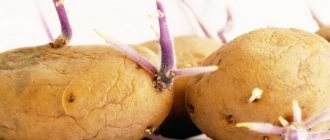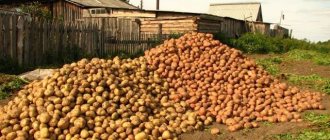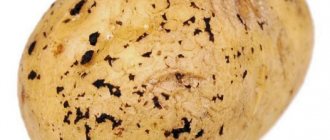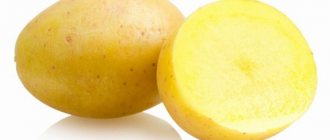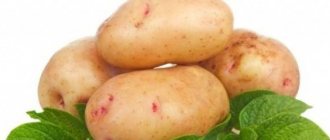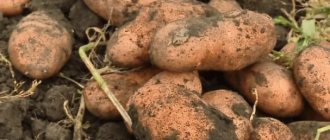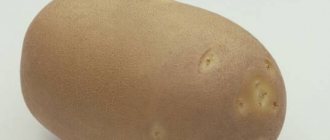Advantages and disadvantages of Lina root vegetable
Potatoes "Lana" are a medium early variety characterized by high yield. The main advantages of this type of root crop are the following:
- Suitable for both cooking and production of chips. Due to its marketable appearance, this plant variety is very popular in the market;
- The variety is not susceptible to potato canker and the action of microorganisms that contribute to the development of late blight. However, the golden nematode poses a danger to the plant;
- Differs from many other varieties in good taste;
- Has an excellent presentation;
- Frost resistance, drought resistance;
- In addition, this variety does not require special care.
Disadvantages of the variety:
- High starch content – up to 18%;
- The umbilical part is strongly pressed into the tuber.
One of the highest-yielding types of root crops is “Lina” potatoes. The positive characteristics of this variety were compiled by the best specialists in the field of plant growing; the root crop is resistant to droughts and heavy rains. The peculiarity of the root vegetable is that the plant does not require special care, but has an attractive presentation: a smooth surface with small eyes, an oval shape. All fruits are practically the same size.
POTATO VARIETIES OF SIBERIAN BREEDING.
Potato breeding in Siberia is developing very dynamically nowadays. New products appear every year. This year I received 2 of the new varieties - Derzhava and Credo. They showed themselves well, did not get sick, and were productive. The tubers have a good presentation.
I was especially surprised by the already well-known Kemerovo variety Tuleevsky
. I've been growing it for several years, but before it didn't stand out in any way. The harvest was small - 1 -2 kg per bush. I thought it was overhyped in the media. What influenced him so much this year? When planting, all varieties were fertilized to a minimum. Due to the rains, it was not possible to do foliar feeding. The only thing I changed in growing Tuleevsky was to plant his tubers on another, wide ridge, 1.5 m in two rows. And the variety has changed - the stems have grown thick, the bushes are tall. When dug up, the tubers turned out to be all large, 3-4 kg under the bush. Well, this variety has excellent taste.
Advantages and disadvantages
Among the main advantages of Azhur potatoes are excellent yields, which are often even higher than those declared by the originator, as well as early and rapid tuberization. In addition, the variety is valued for its taste and high starch content (14-16%). Suitable for various types of culinary processing.
Other advantages of potatoes include:
- excellent presentation of tuber crops, the possibility of growing for sale;
- excellent keeping quality (up to 95%), if favorable conditions are created at the storage location;
- good tolerance to drought and rare watering;
- general unpretentiousness to the composition of the soil;
- resistance to a number of diseases.
The disadvantages of potatoes include the possibility of damage by golden nematode and late blight. Another downside is that young tubers have delicate and thin skin, which is easily damaged when digging for harvest.
Climatic growing zones
The Azhur potato variety can be successfully grown throughout the Central region of Russia. If you grow the variety in the more southern regions of the country, you are guaranteed to get two full harvests. In the northern regions, the variety can also be grown, but only in heated greenhouses.
In all these areas, the yield can reach 400-500 kg of tubers per hundred square meters.
Keeping quality
When creating this variety, one of the main goals was to obtain planting material that would have an increased shelf life.
This problem was successfully solved and now, with proper preparation for storage (manual sorting, sorting), the grown crop can be stored for 5-6 months without a significant decrease in the original quality.
It is very important that in the room where the grown crop will be stored, the air temperature should be regularly maintained in the area from + 2 to + 4 degrees Celsius. Other requirements for the storage location for potato crops can be found here
POTATO VARIETIES BREEDING BY N.M. GADZHIEV AND V.A. LEBEDEV.
Sorcerer
It grew and bloomed beautifully, as always, the stems are thick, the tubers are large.
The harvest from each bush is 3-4 kg. Resistant to late blight. Naiad
is a productive variety, prolific, does not crack, rot, or get sick in wet weather.
League
– the tops of this variety are not tall and are only moderately resistant to late blight. But the tubers are very beautiful: medium in size, perfectly round in shape, with a smooth yellow skin.
Hussar
- a wonderful variety, does not suffer from anything, the tops were green until harvesting. Lilac mist - I have been growing it for several years and have no plans to part with it.
Disease resistant, productive, with long stolons. The tubers are large, beautiful and tasty.
Charoite
– this year the tubers were very large, although the variety was early.
Landing Features
Potatoes that have not passed the vernalization stage have low germination characteristics. 3-4 weeks before the planned planting date, the seeds of the Lel variety are prepared for germination.
The tubers are laid out in boxes in one layer. The room for vernalization is chosen to be dark and well ventilated. Daytime temperatures are +13-+17 °C, and night temperatures are +10 °C. 7-10 days before planting, the seeds are heated at a temperature of +20-+22 °C. Within a month, the length of the sprouts on the tubers reaches 1 cm.
Landing dates
The annual potato crop Lel is planted in open ground from the end of April. Monitor daily temperatures. The variety does not tolerate return frosts or sudden temperature fluctuations.
Planting time occurs at an air temperature of +10 °C. The subspecies quickly responds to such conditions with active growth.
Site preparation
The area designated for planting Lel potatoes is dug up and complex fertilizers are applied. To enrich the soil with nitrogen, legumes are sown on the ridge. On the eve of sowing, a small amount of calcium is added to the soil.
The fertility characteristics of the soil increase when peat or black soil is added to heavy, clayey soil. The variety responds well to loose, light substrate. Dense, wet soil leads to rotting of the root system.
Planting scheme
The depth of planting of Lel variety seeds is determined by the characteristics of the soil and the size of the seed material. The average varies from 6 to 12 cm
It is important to choose the optimal depth. If planted superficially in the ground, the tubers will turn green and the quality of the harvest will be low.
Characteristics of the method of planting potatoes in furrows:
- cut grooves at least 10 cm deep;
- apply fertilizers;
- lay the tubers with the sprouts facing up;
- distance between seeds is from 25 to 30 cm;
- the rows are covered with earth using a rake;
- The surface of the ridge is leveled.
Features of cultivation
“Azhur”, like most varieties, needs to be illuminated by sunlight; this must be done 2 weeks before planting. Several times a season during warm winters it is necessary to pick off the sprouts. Planting is carried out from late April to May, when the soil temperature at a depth of 10 cm is about 13 degrees.
ATTENTION! You should not wait for hot days; elevated temperatures, like lower ones, will negatively affect the germination and further development of root crops.
In the fall, the soil must be disinfected, fertilized and dug up to remove weeds. In the spring you just need to dig it up and loosen it.
IMPORTANT! Potato planting areas should not border on tomato plantings; potatoes should also be planted away from apple trees.
Mulching
legumes "Azhur" loves potash fertilizers
Read more about how to feed potatoes, when and how to apply fertilizers, and how to do it correctly when planting.
After planting, potatoes can be treated with agents to remove and slow down the growth of weeds. When the first shoots appear, this will no longer be possible. To prevent the appearance of new weeds, mulch the rows. "Azhur" tolerates drought well, but in dry summers some irrigation will not hurt.
Potatoes should be hilled, loosened, and excess grass removed. Spraying with microbiological fertilizers is necessary several times during the season (1 - at the emergence of seedlings, 2 - during the flowering period). The flowers should be removed so that all growth goes into the roots.
We have prepared for you a whole series of articles about ways to grow potatoes. Read all about the modern potato business and Dutch technologies, how to grow early varieties and get a harvest without weeding and hilling.
And also interesting methods: under straw, in barrels, in bags, in boxes and from seeds.
Potatoes "Laura": varietal and agrotechnical features
Characteristics of the variety
The Laura potato was bred as a highly productive replacement for the Scarlet variety and has now almost completely replaced it in Europe. The bushes are tall, the leaves are dark green, the color of the flower corollas varies from white to pale purple. The roots have an attractive elongated oval shape, are covered with a red skin and have superficial eyes. The pulp is pronounced yellow. Starch content - 16.4%.
The average yield is 5.5-6.5 c/ha. The yield of marketable tubers reaches 9%. The shelf life level is at least 90%. The weight of a marketable tuber varies from 90 to 150 g. The description of the variety and its characteristics confirm high resistance to diseases and viral infections. The taste is excellent. The pulp does not change color after cooking. Laura potatoes are very convenient for washing and packaging, and are also perfect for making French fries.
Planting potatoes
Preparing potato tubers for planting is one of the most important stages in growing this vegetable crop and begins in the first ten days of April:
- re-sorting of planting tubers with the removal of all defective, disease-affected, deformed and too small;
- vernalization of potato tubers, that is, their germination in the sun or light for 7-10 days until high-quality sprouts are formed;
- treatment of selected tubers before planting with products based on copper, zinc, boron, molybdenum and manganese, as well as dressing with insectofungicidal agents;
- treatment of planting material with a solution of gibberalin, sodium humate or heteroauxin.
Planting dates may vary, but it is necessary to plant potatoes when the soil temperature at a depth of 9-10 cm reaches +7-8 °C, and planting too early in unheated soil (as well as too late) reduces the yield. It is strongly recommended not to force the timing of planting potatoes.
There are different methods for planting potatoes, but the main ones are represented by smooth and ridge methods. Potato tubers should be planted in a row at the rate of 5-6 pieces per linear meter. Regardless of the chosen planting technology, the soil for planting must be carefully dug up, cleared of weeds and fertilized using manure or humus. After planting, the area should be leveled with a rake.
Features of care
Potatoes "Laura" are responsive to quality care. Some modern technologies for planting and growing potatoes can significantly reduce the number of the most labor-intensive activities. For example, when growing potatoes under straw mats, soil loosening operations are removed from the care process, and there is also no need to hill up potato bushes.
Care measures for traditional potato growing technology are as follows:
Post-emergence treatment of the planting area using the method of continuous harrowing is carried out after the rows are designated and the potato tops reach a height of 8-10 cm
In addition, it is very important to keep the potato plantings loose and free from weeds throughout the entire growing season. In the phase of increased growth of tops, the most important thing is the qualitative provision of plants with nitrogen components, and the amount of nitrogen increases from the moment of germination to the flowering stage, and then the degree of digestibility of this component decreases. Potatoes of this variety are characterized by average demands on the quality of soil composition and the presence of irrigation measures. During periods that are too dry, plants need abundant watering. A vegetable crop such as potatoes reacts sharply negatively to an insufficient amount of potassium in the soil and needs such fertilizers throughout the growing season; The best potassium fertilizer is potassium magnesium, which not only helps to increase productivity, but also significantly improves the quality characteristics of tubers, and also increases the starch content. Against late blight, plantings should be treated several times a season with Ditan M-45, Kuproksat or Pilon, and against the Colorado potato beetle, spraying with Kinmiks is highly effective.
As a result of good agricultural technology based on balanced nutrition, the high productivity of the variety is consistently maintained, and about two dozen tubers are formed in each nest.
Characteristics of the variety
Laura's bush is quite spreading, with high tops. The leaves have a typical shape like other potato varieties. The leaf is wrinkled, there is no fluff. The leaves are medium in size and dark green in color. During flowering, a large number of white flowers are formed on the bush. Sometimes light green inflorescences can be found.
Laura mid-season potatoes. For tubers to ripen, it is necessary that 70-80 days pass from the moment of planting.
The yield is excellent. From 1 hectare of plantings you can collect from 350 to 550 centners of marketable products. One bush, on average, produces up to 20 potatoes.
The characteristics of the tuber are as follows:
- The peel is dense, smooth to the touch, and dark pink in color.
- The eyes are medium sized, not deep set.
- The fruit has an oblong shape.
- The weight of marketable tubers is from 90 to 150 g.
- The pulp is bright yellow, the structure is dense.
- The percentage of starch in the composition reaches 15-17%.
- The percentage of preservation of tubers is 90%.
The root crop has average immunity, which partially protects the tuber from all known fungal diseases and viruses.
Laura is a water-loving potato, so it needs plenty of watering.
How to grow
Laura potatoes successfully tolerate almost any climatic conditions. It grows well in any soil, loam and sandy loam. The highest productivity is shown in black soil regions, but in arid regions the productivity of the variety is low.
Planting dates and scheme
The timing of planting varieties depends on the region. In cold soil, potatoes will rot and will not sprout, and late April frosts will completely destroy the plantings. Therefore, in the southern regions Laura is planted at the end of April, in the northern regions - in mid-May. The soil should be warmed up to +7...+8°C at a depth of 9-10 cm.
Before planting, seed potatoes are prepared. To do this, it is first sorted out, leaving only medium-sized, intact and disease-free tubers.
The next stage is germination for 12–14 days in the sun or light. Then the tubers are treated with products based on zinc, boron or manganese, and sprayed with a solution of gibberellin or sodium humate.
Mineral and bacterial additives are added to the soil:
- superphosphate in granules;
- urea;
- nitrogen-bacterial fertilizing "Ecofit";
- nitrophoska;
- phosphorus-bacterial “Bactophosphine”;
Planting is carried out according to the standard scheme:
- Dig holes no more than 10 cm deep. If the soil is not fertile enough, then add humus or a handful of ash to the depressions.
- The distances between the holes are 30–40 cm.
- 60–70 cm are left between the rows to provide the bushes with aeration and simplify hilling.
Important! Potatoes are not planted next to tomatoes: they have the same diseases and pests. After planting, the ground is leveled with a rake.
During the flowering period, flowers are picked off so that the tubers receive more nutrients.
After planting, the ground is leveled with a rake. During the flowering period, the flowers are picked off so that the tubers receive more nutrients.
To obtain a large harvest, potatoes are provided with proper care. The Laura variety loves watering: it is irrigated at least 3 times per season:
- For the first time - 3 weeks after germination.
- Then before the flowers appear on the tops. During this period, the crop needs water most.
- Water the last time before the end of flowering. After waterlogging of the soil leads to the development of fungal diseases.
Proper soil treatment plays an important role in maintenance. The formation of large tubers depends on this
The main nuances of soil cultivation around potatoes:
- Weeds are removed throughout the growing process: they take nutrients from the ground, attract pests and shade young potato sprouts.
- The soil around the bushes is regularly loosened: this ensures access of water and air to the roots.
- Potato beds are mulched with dry straw to reduce the frequency of watering and weed growth.
- After the tops grow to a length of about 20 cm, the bushes are hilled to saturate the roots with oxygen, increase the number of new stolons, and increase productivity.
- After the first hilling, the procedure is repeated every 3 weeks.
The crop reacts negatively to a lack of potassium in the soil, so it is fed with potassium magnesium throughout the growing season. The product improves the quality of tubers by increasing the amount of starch in them.
Nuances of cultivation and possible difficulties
Although Laura potatoes are easy to care for, there are some difficulties in cultivating them:
- need for frequent watering;
- proper care of the soil in the beds;
- preparing soil and potato seeds before planting;
- compliance with the bush placement scheme;
- compliance with crop rotation rules;
Diseases and pests dangerous to the variety:
- Blackleg. A characteristic sign is a black coating on the lower part of the stem. The tops turn yellow and rot, and are easy to pull out of the ground. The tubers are covered with wet mucus. The disease has no cure. Affected bushes are removed, the soil is disinfected with a solution of 1 tbsp. l. copper sulfate with 1 tbsp. ash.
- Colorado beetle. Insects lay eggs on the leaves, and beetle caterpillars (larvae) eat the tops. This significantly worsens the harvest. If the number of adults and larvae is small, they are collected by hand. In case of severe damage, use the Kinmiks insecticide according to the instructions.
- Wireworm. The pest makes tunnels in the tubers, as a result the potatoes are not stored for long. To combat wireworms, fresh potatoes and carrots are placed on wooden sticks and buried to a depth of about 10 cm. After some time, they are removed from the soil along with the insects.
- Medvedka. The insect lives underground, eats roots and tubers. They get rid of it with an infusion of hot pepper and water or with the help of chemicals.
The variety is resistant to nematodes, leaf curl, Y-virus and scab, and has relative immunity to late blight.
Important! The last chemical treatment against pests is carried out no less than 30 days before harvest.
Planting potatoes in open ground
Even a novice gardener can grow Laura potatoes on his own plot. Planting this crop is quite simple and does not require special skills, however, it is necessary to perform preliminary preparation of the soil and planting material, as well as select the most suitable time for planting seed tubers in the ground.
Potatoes should be planted at average temperatures, preferably in mid-to-late May, when soil temperatures are quite high.
Soil requirements
In order to achieve high yields, this potato variety is recommended to be grown only on loose and fertile soils. Chernozem, as well as peat and soddy-podzolic soil of neutral acidity, are best suited for this.
Important! At the time of planting, the minimum soil temperature at a depth of 10–12 cm should be at least +8…+10°С.
The basic rules for preparing the soil for planting the Laura variety are listed below:
- in the fall, before the onset of frost, remove all plant debris from the site and dig up the ground to a depth of about 30 cm;
- during the autumn digging of soil, 7 kg of rotted manure, 35 g of superphosphate and 15 g of potassium sulfate are added per 1 m² of area;
- in the spring, the area is dug up again to a depth of 10–15 cm, after the ground has thawed and can be processed;
- To increase the resistance of potatoes to diseases and pests, the soil is disinfected a month before planting tubers - for this, it is watered with an aqueous solution of Formalin (250 ml of the product per 10 liters of water) or Fitosporin (6 ml of the substance per 10 liters of water), spending 1 m² about 10 liters of mixture.
Good precursors for potatoes are cereals and legumes, cabbage, cucumbers, pumpkin, corn and onions, and bad ones are sunflowers and tomatoes.
Deadlines for planting
When choosing the time to plant Laura potatoes, you need to take into account the climate conditions of a particular region. Planting material immersed in too cold soil may rot and not sprout, and late frosts in April can completely destroy plantings of this variety. Therefore, in the southern regions, the Laura variety is planted in the soil at the end of April, and in the northern regions - starting in mid-May.
Did you know? Potato pulp is 80% water.
Preparation of planting material
To improve germination and protect the Laura variety from diseases and pests in the future, it is recommended to carry out preliminary preparation of seed tubers for planting. The procedure is carried out in April - 3-4 weeks before the planned planting of potatoes on the site.
To do this you need to follow these simple steps:
- sort through the planting material, removing rotten and damaged fruits - for planting it is recommended to choose identical-sized specimens weighing about 90 g so that seedlings appear evenly;
- 2 weeks before planting on the site, transfer the seed potatoes to a well-lit place - this will stimulate the formation of sprouts;
- before planting in the soil, immerse the tubers for half an hour in a solution of copper-containing preparations - this will increase the crop’s resistance to diseases and pests;
- You can carry out additional disinfection of seed tubers with insectofungicides (for example, “Prestige”) by preparing a solution of 100 ml of the drug and 6 liters of water - the resulting mixture is enough to spray 1 quintal of tubers to protect against pests. This procedure is carried out only if the gardener does not plan to eat new potatoes;
- for additional protection from the Colorado potato beetle, each potato can be sprinkled with wood ash powder;
- treat the fruits with a solution of gibberellin - this will stimulate the active growth of the plant and speed up the emergence of seedlings.
Video: processing potatoes before planting
Landing technology
After the preliminary preparation of the soil and planting material has been completed, they begin to plant the seed tubers in the ground. Laura potatoes can be planted using ridge or smooth methods. In the first case, the holes for tubers are located on the top of the ridge formed from the soil, and in the second - on a flat surface of loose soil. But, regardless of the chosen planting method, plants need to be placed in even rows on the site.
Step-by-step instructions:
- Mark rows on the site, placing them at a distance of 60–70 cm from each other.
- In each row, dig holes about 10 cm deep. The distance between adjacent holes in the row should be 25–30 cm.
- Place a handful of wood ash or a pinch of humus at the bottom of each hole.
- Place the seed in the hole, positioning it so that the sprout points upward. Cover the hole with a layer of soil about 5 cm thick.
- After planting the planting material, level the soil surface in the area with a rake. If the soil is too dry, you can water the beds with a small amount of water.
Video: planting potatoes
Diseases and pests
Potato variety “Laura” has immunity against:
- Virus Y;
- Nematodes;
- Leaf curling;
- Scab;
- Late blight of tubers and shoots.
However, the possibility of infection of the plant should not be ruled out. The main causes of diseases:
- Growing potatoes in the same area for a long period;
- Use of low quality seed tubers;
- Too dense planting of bushes;
- Growing on depleted and infertile soil.
Potato variety “Laura” has a high rating and positive reviews. Gardeners are attracted to the “Laura” variety because of the beautiful elongated oval shape of the tubers, which have rich yellow flesh that does not change during heat treatment. Potatoes are used to make high-quality French fries. “Laura” has high consumer properties, and therefore is often grown by potato growers for sale.
Potatoes of the “Laura” variety have many advantages, such as high yield, excellent taste and aesthetic qualities. To get a high-quality harvest, you must follow the rules of planting and caring for the plant, take into account the recommendations and advice of experienced vegetable growers. Creating favorable conditions for the growth and development of Laura potatoes will allow even beginning gardeners to get an excellent harvest.
We invite you to familiarize yourself with potato varieties that have different ripening periods:
Did the article help you?
Already helped once
With the beginning of spring, the summer season begins and gardeners rush to their garden plots. Popular vegetable crop
Potatoes "Giant" are classified as promising varieties that guarantee stable high yields. Is different
Description of the variety
Roots:
- The tubers have an oval, slightly elongated shape;
- Dense dark red peel;
- Deep yellow flesh when cut;
- Starch content 16.5%;
- Medium ocelli;
- The average weight varies from 80 to 150 grams.
Potato harvest "Laura":
Bushes:
- The plant is spreading, tall, large, erect;
- Dark green leaves, typical potato shape, wrinkled, no edge;
- Many inflorescences;
- The corolla is often white, but can be light purple.
Characteristics and description
The mid-early variety Laura has already established itself as the best among red-skinned hybrids, but for a good harvest you need a large percentage of black soil in the soil. In addition, Laura potatoes do not tolerate drought well.
Appearance: Shoots. The bush of this variety reaches large sizes. The stems are erect with dark green foliage, which is located at small intervals, which is typical for this crop. During flowering, a large number of white or light purple inflorescences appear on Laura potatoes. Roots. The root system is well developed, which allows the formation of up to 20 oval tubers of medium size (70-90 cm). Root vegetables have a dark pink color with a smooth surface. Presentation is ensured by a small number of eyes. The cut flesh is yellow, which indicates a high starch content in the tubers.
Productivity per 1 ha. Laura belongs to the mid-early varieties. For sowing, root crops without mechanical damage weighing 70-90 g are recommended
When choosing tubers, you need to pay attention to green spots on the skin; their presence indicates that the root crop is sick. The average yield will be from 330 to 500 c/ha, provided that you plant about 42 thousand tubers in well-fertilized soil (according to the originator).
Taste characteristics
According to the classification of the European Potato Research Association, the Laura variety belongs to the culinary type “B”, and can be used for preparing any dishes. Root vegetables, despite their high starch content, retain their shape during heat treatment. Potatoes are suitable not only for side dishes and mashed potatoes, but also for deep frying.
Chemical composition. The presence of a high content of starch, potassium, phosphorus and vitamins B and C in potatoes makes its juice popular in the treatment of viral diseases, normalizing blood pressure and lowering blood sugar levels.
Average weight of tubers. During the ripening period of 70 to 80 days, the tubers gain weight from 90 to 150 g. At the same time, the starch content in them is 15-17%.
Marketability. The Laura variety has a dense peel, but during transportation, 10% of the tubers lose their presentation.
Resistance to diseases and pests. Laura potatoes, like the Red Scarlet variety that precedes it, have average immunity to major potato diseases and viruses.
Attention! When exposed to sunlight, a toxic substance, solanine, appears in root vegetables, which makes them unsuitable for consumption.
Keeping quality. This variety does not lose its taste and presentation when properly stored. Keeping quality is up to 90%.
Consumer qualities. This variety has proven itself well in industrial cooking. It is used to prepare various semi-finished products, vegetable mixtures and chips, but its delicate aroma and exquisite taste are especially noticeable when deep-frying.
Growing regions. Laura potatoes belong to the mid-early varieties and can be grown throughout the Russian Federation. But it produces greater yields on light, fertilized soils of the Central and Northwestern regions of Russia.
Description and characteristics of the variety
Laura is part of the line of productive mid-season potato species. The growing season before harvesting lasts 70-80 days. Keeping quality is 90% if the temperature in storage is maintained at 1-4 degrees.
The variety is moisture-loving, productivity increases with additional moisture.
The variety has spreading, vigorous bushes. The length of the tops is 60-70 cm. The arrangement is semi-erect, the stems do not lie down. The foliage is moderate, the leaves are rich green in color, with a wavy edge. Leaf blades are medium sized. The buds are white, sometimes there are flowers with a light green tint. On the stolons of 1 bush, 15-20 tubers of impressive size are tied (there are no small things).
What is useful to know about tubers:
- average weight 90-150 g;
- elongated-oblong shape;
- eyes are medium (set 2-3 mm deep);
- the color on the outside is dark pink;
- the flesh is yellow;
- the consistency is dense (moderately boilable when cooked);
- the surface is smooth;
- starchiness at an average level of 15-17%.
The State Variety Commission rates the taste quality at 4.6 points. Potatoes are suitable for a variety of dishes - mashed potatoes, roasts, stews, appetizers, borscht, solyanka, soups. When boiling, baking, frying, the flesh does not darken.
History of the variety's creation
The Laura potato was bred by breeders of the German agricultural group. The creators are farmers from Europlant Pflanzenzucht GmbH. The variety has not yet been included in the State Register.
Potato variety Zhukovsky early
The Zhukovsky early variety refers to very early potato varieties. It has a high, stable yield in different climatic zones and different soils. The Zhukovsky variety blooms strongly, with red-violet flowers. A bush of medium height with numerous shoots. Tubers with pink skin, oval shape. Excellent taste (potato variety suitable for making chips).
Large yield of marketable tubers (that is, they are all large, small ones are practically absent). This potato variety is resistant to cancer, potato golden nematode, common scab and some other viruses and diseases. It is worth noting that the potential yield of the Zhukovsky early variety is 600 c/ha. - this is a very high yield. And the average is 300-400 c/ha.
Positive and negative sides of Laura
The Laura variety has a number of advantages:
- Potatoes are large in size.
- The variety is high-yielding.
- Has fairly good immunity.
- Excellent taste.
- Long shelf life.
At the same time, there are a number of disadvantages:
- Despite the fact that the shell is quite dense, the variety is susceptible to mechanical damage.
- Laura gives a good harvest only in fertile soils that do not suffer from a lack of potassium.
- The variety reacts negatively to the herbicide Metribuzin. This herbicide is used for industrial purposes to remove weeds.
Seed potatoes: how to choose
Since potatoes are propagated mainly by tubers, the main share of success depends on the quality of planting material.
Why shouldn't you use your own potato planting material?
Potatoes, like no other crop, are easily affected by diseases: viral, bacterial, fungal and other infections penetrate through the leaves and accumulate in the tubers. In addition, varieties tend to degenerate. Therefore, you should not constantly use your own planting material - this will affect the harvest. Once every 3-4 years it needs to be updated by purchasing elite planting material grown in a specialized farm. The process of obtaining the “elite” is long and expensive; it begins with growing healthy plants in vitro and takes five years.
What size should tubers be for planting?
When choosing planting material, pay attention not only to taste, color, yield, but also to where the varieties are zoned, as well as to the ripening periods: early, middle, late. The characteristics of the variety are also important, for example, resistance to diseases, nematodes, etc.
It is better to choose large potato tubers (50–100 g) for sowing; only from them can strong plants grow that can produce a large harvest.
Caring for Laura
Laura potatoes, like any other variety, love high-quality care. Basically, caring for potatoes comes down to two procedures: watering and hilling.
Watering
Laura potatoes are one of those varieties that love high-quality watering. For this reason, bushes need to be watered at least three times during the growing season:
- 20 days after the appearance of the first shoots. Earlier watering is not recommended, as it can cause inhibition in the development of tubers.
- Before flowers appear on the tops. During this period, watering should not be skipped under any circumstances, since the crop really needs water.
- Before the end of flowering. You can immediately after the flowers disappear.
It is very important to understand that watering the bushes after flowering is extremely undesirable. This is explained quite simply
After flowering, potatoes enter the “ripening” stage. At this time, the immune system becomes vulnerable to fungal diseases.
Hilling
It is necessary to hill up potatoes. In addition to the fact that this procedure allows you to loosen the soil and saturate it with oxygen, it also removes weeds from the garden and helps the formation of new stolons, which significantly increases the yield (by 20-30%).
We recommend reading: “Description of the Lapot potato variety”
Laura is spudded twice per season:
- When the tops have become high enough (about 20 cm).
- 3 weeks after the first agricultural work.
Potatoes Laura: description of the variety
The homeland of the Laura potato variety is Germany. It is grown in any climatic conditions, even in regions with risky farming. The best results were obtained by gardeners in the North-Western and Central regions.
For normal development of root crops, a temperature of 22-25 C and high humidity air are required. The crop can tolerate dry periods and recovers quickly after them. What are the characteristics of potatoes? What kind of care does it require?
How to care?
When caring for potatoes of the Laura variety, it is necessary to take into account its characteristics. The culture is moisture-loving, so it is necessary to organize regular watering for it. Surface irrigation is not practiced; irrigation liquid is injected under the root.
For young plants, up to 5 l/bush is required. The volume of water is gradually increased. By the budding period, the amount of water is adjusted to 12-15 l/bush.
The frequency of approaches depends on weather conditions. If it rains often in the region, then watering is not carried out. In extreme heat and drought, moisten the soil once a week. Waterlogging and overdrying are not allowed. To do this, peat or straw is placed in the beds.
More on the topic: What are the characteristics of 40-day-old potatoes?
If precipitation was able to moisten only the top layer of soil, then full watering is carried out. The soil should always be soft, moist at a depth of 30 cm.
Potatoes require hilling so that the maximum number of tubers develops on the bush. If planting was carried out in a ridge, then the shape of the bed is adjusted.
| 1 | young potatoes are hilled to the bottom leaf. In some cases, bushes are completely covered with soil |
| 2 | when buds form on plants. The second hilling is carried out, the height of the hill should be at least 18 cm or half the length of the stem |
| 3 | The third time the potatoes are sprinkled during the flowering period; cover ½ of the stems |
The soil should always be moist. Dry soil is not suitable for hilling plants; it needs to be watered first. In dry and warm soil, tubers can rot.
Heat and drought are favorable microclimates for common scab. During hilling, weeds are removed along the way. It is recommended to update the mulch; pour straw, peat, sawdust or sand into the beds.
Laura potatoes develop normally without fertilizing if the soil for root crops has been prepared correctly. To increase the immunity of plants, they practice irrigating bushes with “Potassium humates”, “Shine-1”, and the drug “Baikal”.
The complexes not only replenish the potato’s mineral supply, but also protect it from pathological microflora. A good fertilizer and antiseptic is boric acid, 5 g/10 l. It is recommended to use it before the ripening period.
The originators recommend growing Laura potatoes; it is necessary to study the description of the variety, reviews of experienced plant growers. Among the advantages of this culture, increased immunity is noted. Plants develop normally throughout the growing season without fertilizing.
Gardeners do not use complex mineral complexes; most often they introduce a weed solution. It can be used as an independent fertilizer or as a basis for complex fertilizer.
Potassium salt, superphosphate, yeast, and ash are added to the solution; 300-500 ml is injected under a young bush, up to 1 liter under an adult plant.
More on the topic: How to grow potatoes Hostess?
After each negative change in the weather, the bushes are irrigated with an ash solution, the drug “Fitosporin”, or an infusion of tomato or potato tops. If brown or yellow spots develop on the leaves, then use copper sulfate, Bordeaux mixture, or Actellik.
These drugs are fungicides. They destroy zoospores of late blight, pathogens of fusarium, scab, powdery mildew, and have a negative effect on the mosaic virus.
If a potato suffers from scab, cancer, fusarium, late blight, then it is no longer possible to cure it. Affected bushes are removed from the garden. They are dried and burned. The remaining plants are treated preventively with fungicides. The seed material is changed. When preparing a bed for potatoes, the top fertile layer is removed and new organic matter is introduced.
If potatoes are planted in early May, harvesting is planned in mid-September. For northern regions, it is recommended to dig up root crops before frost.
Store potatoes in a cool, dark room, at a temperature of 2-4 C, with a humidity of 80%. Ventilation must be provided in the storage area. It is recommended to place root crops in nets and secure them on vertical posts. This way the tubers are well ventilated.
Potatoes have a high shelf life. It is stored until the next harvest, but at the end of storage the pulp loses moisture and becomes elastic.
Characteristics of potatoes Laura
Laura potato is a mid-early red-skinned variety for table use. Description of the variety:
- red, dark shade of smooth skin with medium-sized superficial eyes;
- the pulp is dense, rich yellow in color;
- the tubers have a regular oval shape;
- the mass of tubers ranges from 90 to 140 g;
- tuber length – from 7 cm or more.
The tall, upright bushes are quite spreading and covered with dark green foliage with a wrinkled structure. The medium-sized leaves without pubescence are located intermediately, which is typical for this vegetable. There are a lot of inflorescences. The corollas of the flowers are distinguished by a white and pale purple hue.
Note! The value of potatoes is determined by the amount of starch. The Laura variety of potatoes has a yellow tint to the flesh, which indicates a high starch content, which reaches 16.5%.
Potato productivity is high, the maximum result depends on the timeliness of planting and weather conditions. One bush produces up to 20 tubers, 1 hectare - about 330 centners.
Exposure to sunlight leads to the appearance of green spots on potatoes, which signals the presence of poisonous solanine and the vegetable's unsuitability for food. The same applies to tubers with sprouts.
Taste characteristics
Laura potatoes are a table variety (culinary type “B”). A distinctive feature of the variety is its excellent taste, aroma, and preservation of the color of the pulp during heat treatment. Storage, transportation, and heat treatment do not affect the taste of the vegetable. The excellent nutritional properties of potatoes make them a welcome guest on the table.
Note! The excellent taste of potatoes is complemented by substances beneficial to health: a high content of phosphorus, potassium, vitamins B, C and other beneficial substances. A large amount of starch has an antiviral effect. Potato juice from the pulp and peel helps normalize high blood pressure and lower blood sugar levels. Due to their high degree of starchiness, Laura potatoes are ideal for making mashed potatoes or French fries. It can also be fried, baked, boiled.
Potato fries Laura
Rosara potatoes, variety description, photo
This is an early potato variety, the ripening period is 70-75 days. Rosary bushes are medium-sized, semi-spreading with red-violet flowers. The tubers of this variety are elongated-oval, with thin skin and small eyes. Potatoes are red, but yellow when cut. These are very tasty potatoes. Each mature tuber weighs 80-115 g, their number in the nest is up to 18 pieces.
The Rosara potato variety is resistant to potato nematode, cancer and relatively resistant to scab and late blight. The variety is valued for its stable and high yield and excellent presentation. The most productive variety of all red potato varieties.
The history of the origin of the potato variety "Laura"
Potato variety "Laura" was developed by breeders from Germany; it replaced the popular variety "Scarlett".
Sofa settee in a modern interior: elegance and comfort (24 photos)
Today, the most productive variety of red-skinned potatoes.
Originator: EuroplantPflanzenzuchtGmbH (Germany). There is no official registration in the State Register.
The table presents data on the mass of marketable tubers (grams) of different varieties:
| Name | Variety | Weight |
| Nikulinsky | Late ripening | From 70 to 120 |
| Cardinal | Late ripening | 65-110 |
| Rocco | Late ripening | 100-120 |
| Picasso | Late ripening | 80-140 |
| Borovichok | Early ripening | 120-200 |
| Elmundo | Early ripening | 120 |
| Felox | Early ripening | From 100 to 120 |
| Bellarosa | Early ripening | From 120 to 210 |
| Karatop | Extra early | From 58 to 100 |
| Zhukovsky early | Extra early | 100 to 120 |
| Farmer | Extra early | From 90 to 110 |
| Minerva | Extra early | From 120 to 245 |
| Sorcerer | Mid-late | From 75 to 120 |
| Mozart | Mid-late | From 100 to 150 |
| Grenada | Mid-late | From 800 to 100 |
| Melody | Mid-late | From 95 to 180 |
| Giant | Mid-early | 100-140 |
| Tuscany | Mid-early | From 90 to 125 |
| Purple Haze | Mid-early | From 90 to 160 |
| Openwork | Mid-early | 90-120 |



